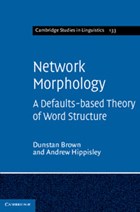The theory of Network Morphology
Project Overview
Project
The theory of Network Morphology
Project members:
Prof Greville G. Corbett
Dr Norman Fraser
Dr Dunstan Brown
Period of award
September 1992 - August 1995
Funder:
Economic and Social Research Council (ESRC)
As part of the attempt to define the possible structures of human language, this project led to the development of a formal approach to model the diversity of possible morphological systems.
We analysed the word-structure of a typologically diverse set of languages including those with radically different morphological systems from English. The framework within which the principles of possible variation are articulated is called Network Morphology. Analyses are represented in the lexical knowledge representation language DATR, allowing computer verification of the accuracy of the analyses. Thus, this research constitutes a contribution to the fields of linguistic typology and morphology, using formal computational methods.
Network Morphology was initially developed for representing complex data from Russian. This development contrasted languages which have morphology at opposite ends of the spectrum of possibilities. Slavonic languages (Bulgarian, Polish and Russian) represent languages with fusional morphology (where disparate information is packed into small segments). They were contrasted with two polysynthetic languages (the Eskimo language Yup'ik and the Australian language Mayali) which can build up long, complex but segmentable word-forms.
For each language a computational model was developed using DATR , so that we could make and evaluate explicit theoretical claims and check that the correct forms were indeed predicted. Understanding the range of possible human languages enables us to understand our own, for theoretical and practical, computational purposes.



